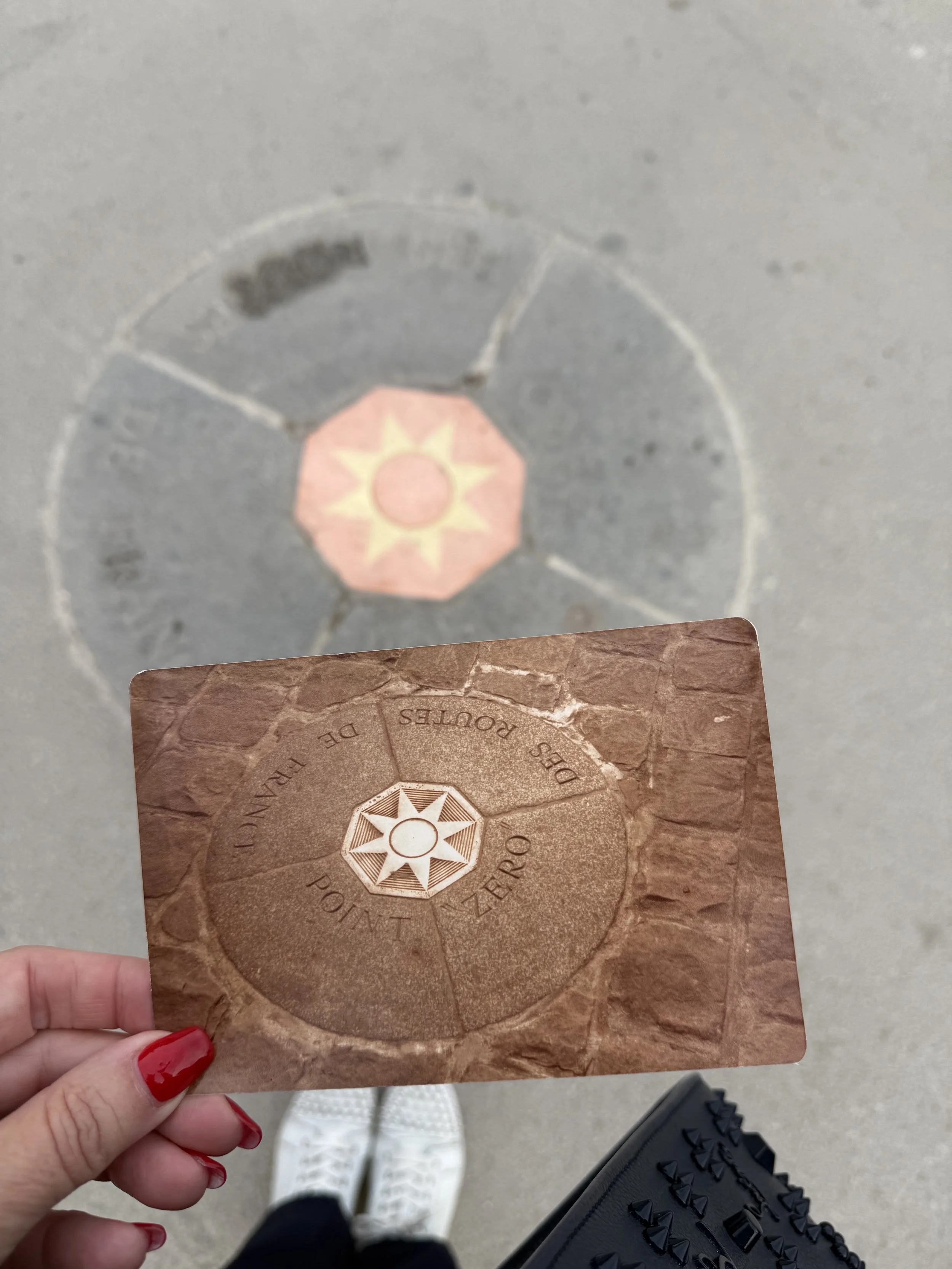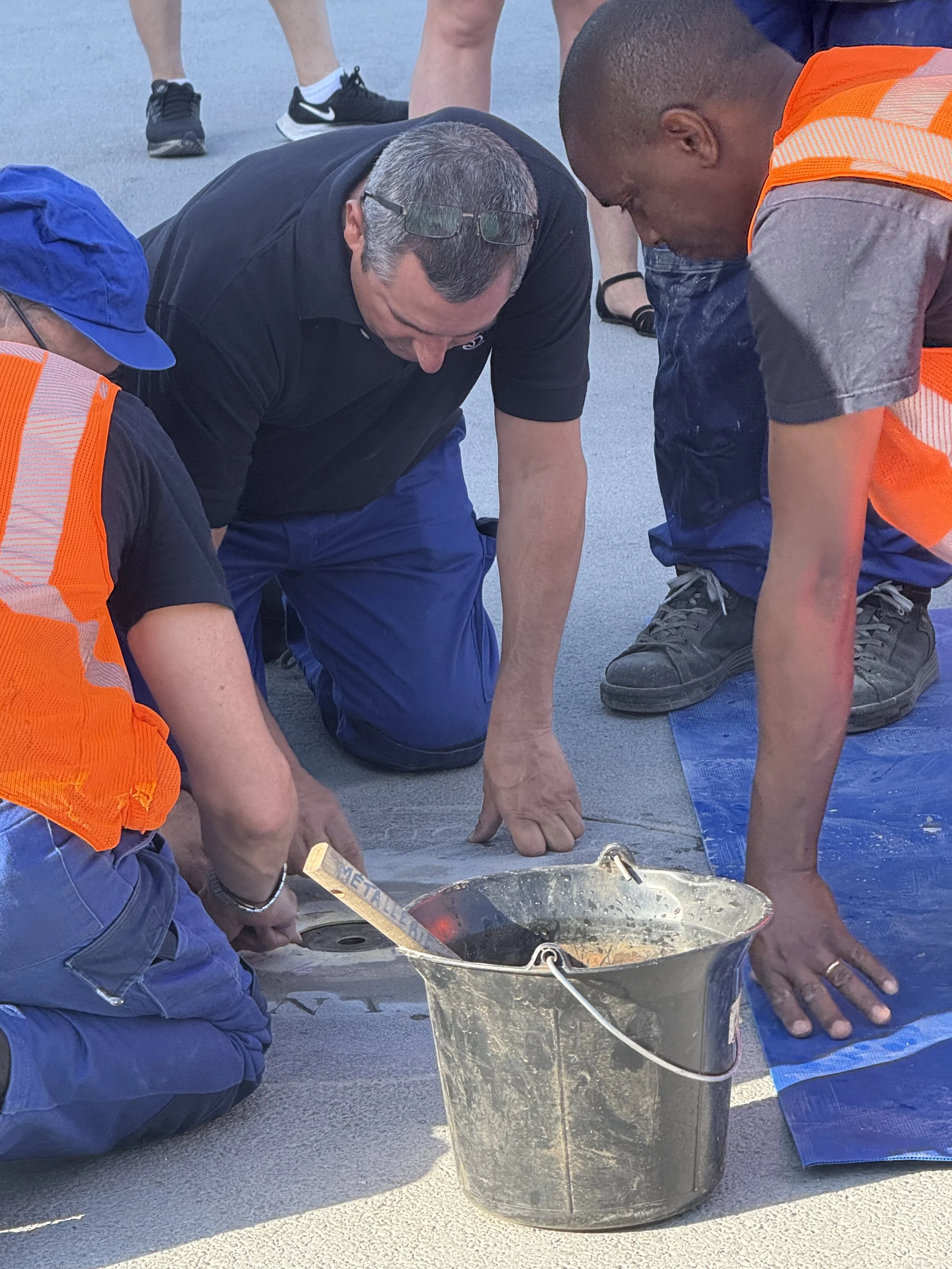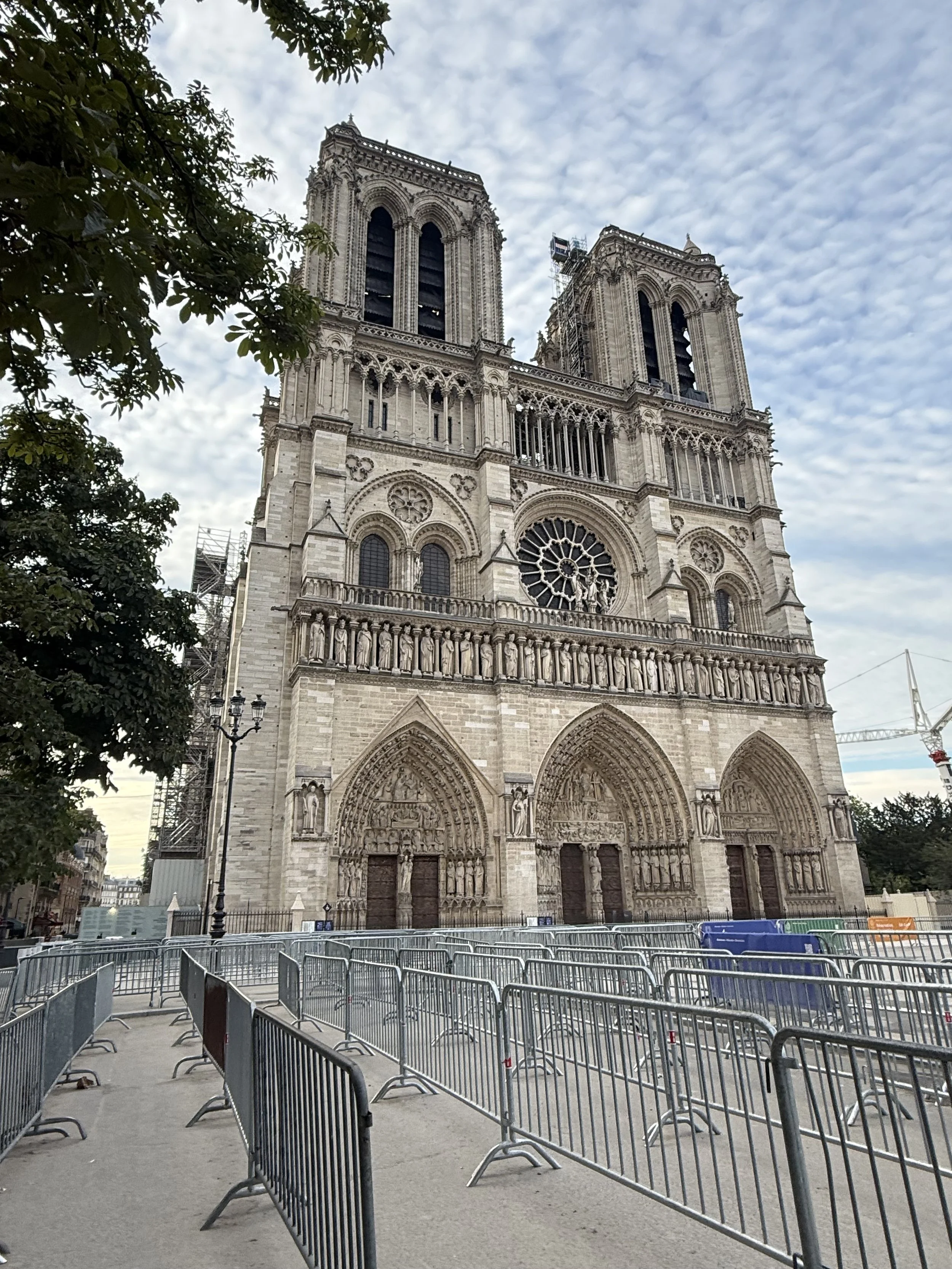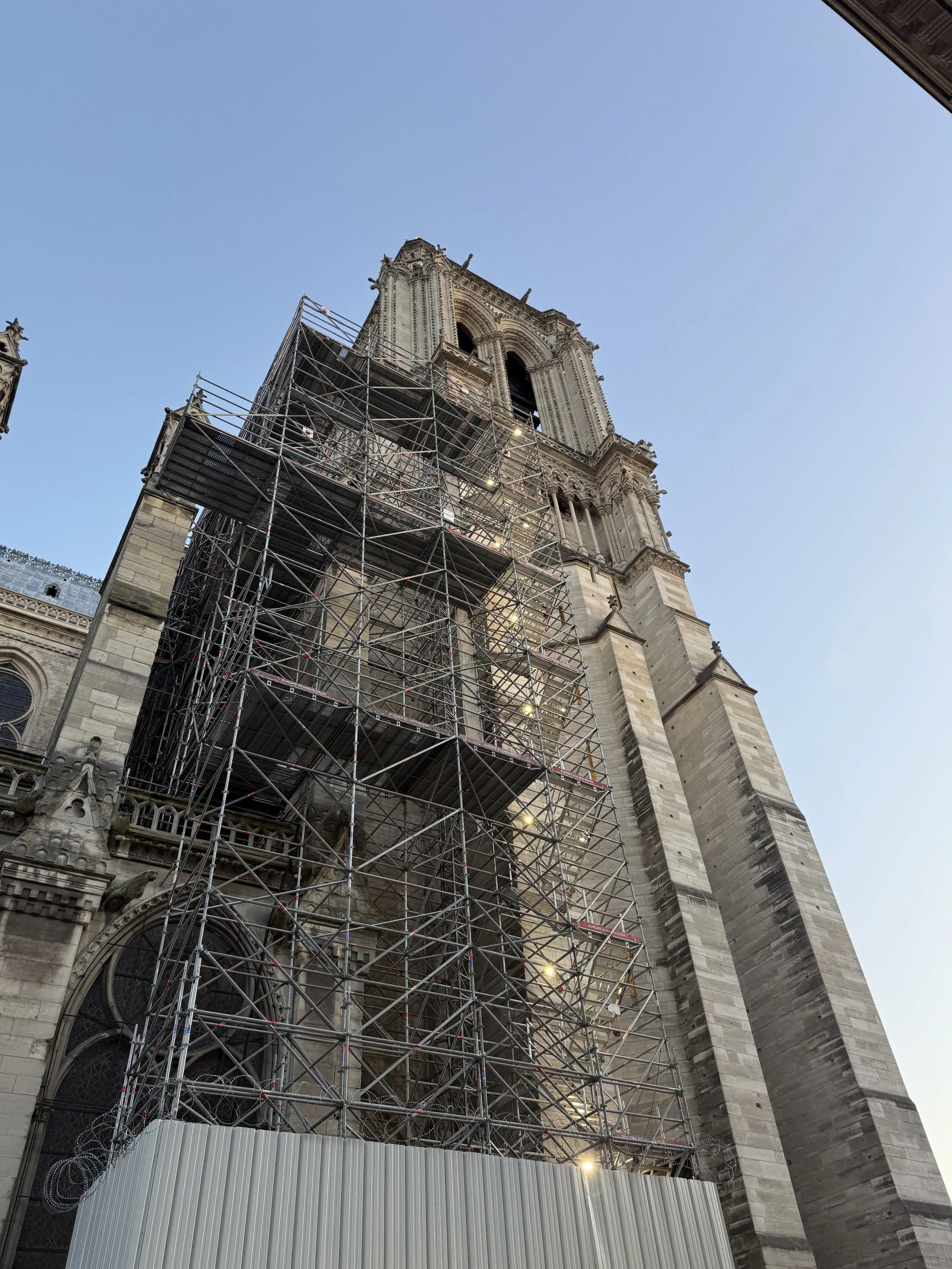In the last few days of November 2024, as the space in front of Notre Dame once again reopened, there was only one thing I wanted to see: the Point Zero. Sadly, I was disappointed, that is, until yesterday.
Just a few feet away from the visitors' entrance, for one hundred years, a brass marker has been embedded in the parvis of Notre Dame. On April 22, 1769, Louis XV created a patent measuring all roads from a single point in Paris, known as Kilomètre Zéro. It took a bit longer for the marker to be added, precisely 155 years. In October 1924, after a decade of discussion, Georges Delavenne, the President of the City Council, laid the brass plaque at the center of the marker.
The octagonal stone marker is engraved with Point Zéro des Routes de France around its edges. When all roads lead to Rome, the streets of France lead to Notre Dame de Paris. Fourteen national roads are measured from this point to all points of France.
There are many superstitions and rituals associated with the medallion. Some people make a wish and toss a coin, while others believe that if they kiss their loved one standing on the marker, it will be a love that lasts forever.
My favorite was to stand on the marker, spin around clockwise three times, and that means you will return to Paris. I would do this on the last day of every visit to Paris, but that all ended the night of the fire on April 15, 2019. For more than five years, the marker was hidden behind a fence and under protective flooring. The first chance we had to be close enough to it again, I had to find it, although it was still under a protective plate.
On a sweltering hot morning in front of Notre Dame on July 1, I noticed a few men in bright orange vests working. As I got closer, I was excited to see that they were preparing the return of a new brass plaque. Once again, after six years, Point Zero has returned. The original medallion was removed after the fire and will eventually make its way to the Musée Carnavalt. The City of Paris Maintenance and Supply Center hoped to clean and reuse the original, but it was severely damaged and covered in lead. Upon installation, the names of the craftsman were added below the medallion.
After leaving the cathedral, I checked on the plaque, and there it was, as if a day hadn't passed, and not a single person paid any attention. Luckily, I don't have to spin around hoping I return to Paris this time.
My grandparents visited the marker in the early 1980s and snapped a photo. Have they stopped to spin around a few times? They did return many times after that.
Towers
Notre Dame also announced this week that the towers will reopen on September 20.
The two towers of the western facade date to the 13th century. Bishop Maurice de Sully, the creator and father of Notre Dame, died in 1196 and never saw the start or even the completion of the facade. Sully became the bishop of Paris in 1160 and immediately pushed for and funded the construction of a grand cathedral, the tallest in the world, on the Île de la Cité, where the chapel of Saint-Etienne stood.
Construction of the western facade began in 1202. In 1223, the doors and just below the Gallery of Kings were completed, and the north tower began. For 17 years, slowly and day by day, large stones were pulled up the tower until the north tower was revealed in 1240. The south tower was built from 1235 to 1250 and topped with a terrace and balustrade, giving one of the best views of Paris and the roof of Notre Dame. One of my favorite photos of my grandmother is from the top of the south tower, and one I look at every day.
Eagle-eyed visitors may notice that the north, or sometimes called the big tower, is just a tiny bit wider than the south. Four feet wider, the width of one of the statues in the Gallery des Rois. Eight below the north tower and seven below the south.
On the night of the fire, the flames reached the north tower, and that was the moment that everything became critical. The towers house the ten large bells of Notre Dame, eight in the north and two in the south. The bells of the north tower weigh a combined 18.3 tons, housed in the 19th-century belfry rebuilt by Viollet-le-Duc. As the flames neared the tower, the pompiers of Paris knew they had 30 minutes to contain the fire or lose the entire cathedral. Luckily, as we know, they did just that.
Two of the eight bells, Saint Marcel and Saint Gabriel, were damaged by thermal shock, and a few of the rafters of the belfry on the SE side of the tower as well. All of the bells were removed from the north tower, and a significant restoration of the belfry was undertaken, including grafting and replacing the oak on the SE side. The entire belfry was lifted in February 2024, 11 ½ inches off the ground, to replace three of the large supporting pieces.
Over the next two months, the work on the towers will conclude, and they will reopen to the public once again. With a new layout and additions, the visitors' experience will be enhanced, allowing them to share a bit of the cathedral's history and the renovation process. Entering through the base of the south tower, the new oak staircase, designed by Philippe Villeneuve, Pascal Prunet, and Rémi Fromot, will link to the stone stairs, totaling 424 steps, to reach the summit.
The new double helix staircase of the south tower is the largest in the world. At nearly 70 feet high, the 178 steps weigh over 22 tons and are crafted from 1,200 pieces of oak. The entire structure was constructed inside the tower by 15 carpenters, three cabinetmakers, and one wrought iron worker over 9,200 hours. That is over one year of work, bravo to all those amazing craftsmen and women.
Along the way, you will find a model of the cathedral, the story of Viollet-le-Duc and the 19th-century renovation, and a glimpse into the belfry, along with the story of the historic Emmanuel and Marie bells. From the top, a view of all of Paris is before you, and even a closer look at the roof and into the forest.
The descent will be from the north tower, with a few landings, and more of the story of our beloved cathedral.
The price of the visit will increase to at least 16€, and reservations will be needed in advance and available at the official Monuments of Paris website only, and available at the "start of September" (In French, that means just a few days before opening)
Statues
In an unbelievable stroke of luck, just four days before the fire, the statues on the roof were removed one by one. On April 11, 2019, the twelve apostles flew over the streets to head south for a bit of freshening up. The plan was to return them two by two to Notre Dame to be displayed before they were returned to their original location on the roof.
In 1842, Viollet-le-Duc and Baptiste Lassus were selected to rehabilitate the grand lady. His early plan included the addition of two spires on t. The former spire had been removed in 1797 due to safety concerns, and an entire generation never knew the church with a spire. Following the renovation of Sainte-Chapelle, Viollet-le-Duc sought to add statues to the roof and consulted Adolphe Victor Geoffroy-Dechaume, with whom he had collaborated on the restoration of Sainte-Chapelle.
Work began on the Apostles in 1848, and they were more than meets the eye. The inner structure was created with iron and then covered with copper sheets, making for a much lighter statue that could stand far above the streets. In the Périgeux offices of SOCRA, the statues arrived, and the work began. Many of the internal structures had to be partially replaced. Micro-sandblasting with apricot powder removed the outer layer of the patina. A dark bronze colored paint was added and coated with wax, and after a month of work, the statue was complete.
There are 16 total statues, comprising twelve Apostles and four Evangelists. The apostles are created using four different body types, and Dechaume then made each unique with its head, hands, and attributes.
For the past few years, the restored statues have been on display at the Cité de l’architecture et du patrimoine museum in the Trocadéro.
On June 5, 2025, the statues finally arrived back at the base of Notre Dame, awaiting their return to their perch to once again watch over Paris and the cathedral.
The lower open-work portion of the spire is still under construction. Ornamental workers are finishing the lead covering, which is expected to be completed within the next month. The scaffolding will then be removed, revealing the spire once again.
On Monday, July 24, at 7:30 p.m., the statue of Saint Paul was the first to be returned to the roof. Saint Paul, once a persecutor of Christians, had a divine revelation and converted, becoming a preacher. Killed in 64AD with a sword that cut off his head, he now rests his hand on a sword and strokes his beard.
Hidden within the scaffolding, I can’t wait to see him once again, and all his friends return, and the roof return to the creation of Viollet-le-Duc once again.








